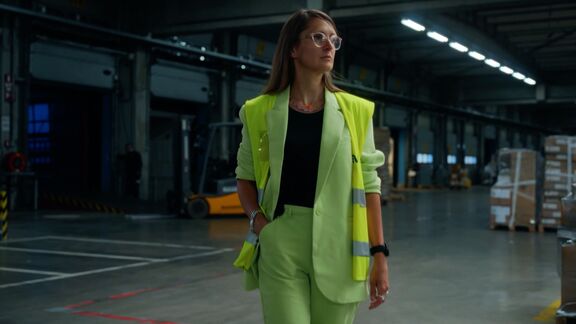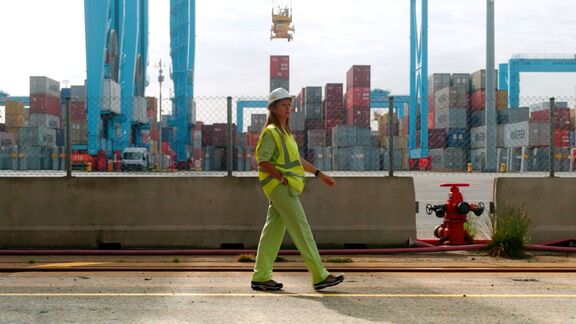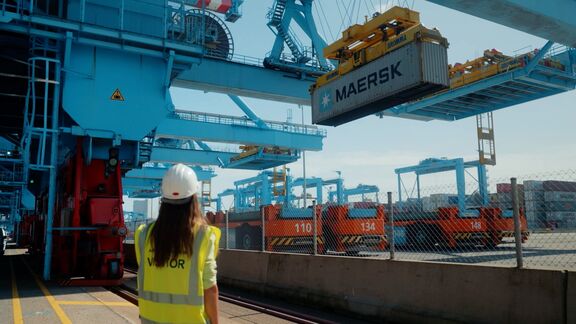Bugaboo on its way to emission-free supply chain
Reading time: 5 minutes
Collaboration crucial in realising sustainability goals
A CO2-neutral society forms the basis for a future-proof world. Making supply chains sustainable is an essential part of this transition, but it also poses great challenges to shippers. A collaboration between supply chain parties may lead to good results, as Bugaboo’s success story proves.
The popular strollers are its main eyecatcher, but Bugaboo’s range of products has lots more to offer for new parents. Its main office is located in Amsterdam, but the vast majority of its portfolio is produced in its self-owned factories in China. From there, Bugaboo ships its products to clients across the globe.
“We operate in the manufacturing industry, which logically leads to a relatively large CO2 footprint. That’s what makes the challenge of reaching our sustainability goals so great. But especially because we have our own production facility, we are able to gain insights into our footprint and to control it directly”, says Lise Hordijk, sustainability manager with Bugaboo.
She knows all too well how ambitious these sustainability goals are. Bugaboo actively promotes a better future. The ultimate goal is zero emissions by 2035. “It’s approaching rapidly, but I am convinced we can make it”, says Hordijk.
Responsible production
According to her, collaboration within the supply chain is essential in achieving the sustainability goals. For Bugaboo, that begins on the production side of the supply chain. “Among other things, we look at our products’ design – how can we use materials differently, and how can we purchase raw materials in a responsible way”, Hordijk tells us.
It has led to a cross-value chain partnership with DSM Engineering Materials (now Envilor) and Neste, among other things. This collaboration led to the successful implementation of bio-based plastics in the Bugaboo portfolio.

“This is one of the materials we use most in our products. By switching to a more sustainable alternative, we have been able to reduce our CO2 emissions related to those products by up to 24%. And of course, without making any concessions regarding quality”, the sustainability manager continues. Bugaboo is currently looking into alternatives for other materials within its production process. “There is still room for improvement for sure”, says Hordijk.
Reducing CO2 emissions
Yet also transportation to retailers and clients across the world, especially using sea containers, has great impact on the shipper’s CO2 emissions.
The lion’s share of all transported containers is headed for the European market and is shipped through the port of Rotterdam. “Rotterdam’s ambition is to be the most environmentally sound hub. This enables us to distribute our products in the most sustainable way possible”, says Hordijk
Along with a number of supply chain parties, the Port of Rotterdam Authority is leading the way in the transition towards CO2-neutral chains – and in a collaboration with GoodShipping, it initiated the Switch to Zero campaign, in which Bugaboo is also participating. Hordijk: “The campaign is more than just a good-looking initiative, and it fits in perfectly in our Push to Zero programme, which is aimed at reducing CO2 emissions rather than compensating for them: insetting instead of offsetting.”
‘Insetting is bringing along a real change’
GoodShipping is the market leader regarding insetting, enabling shippers and manufacturers to transport sea freight using sustainable fuel rather than traditional fossil fuels. The initiative is not with the shipping companies, but with the cargo owners.
What is insetting?
Insetting is the principle that companies use to reduce their ecological footprint, within their own value supply chain. That CO2 reduction is not achieved through compensation, but by actually using more sustainable alternatives. An equivalent amount of sustainable transportation (in other words: CO2 reduction) is purchased through certificates of use of alternative fuels. By using insetting, companies are able to influence their own values supply chain sustainability in an effective way. Also, the principle promotes a supply chain amendment for the longer term.
Replace in maritime shipping | which fuel will be next?
Alternative fuels will play a crucial role in making container shipping net zero. But what will be the fuel of the future? When can we expect zero-emission shipping? And what is the role of carbon insetting? We explore this in episode 4 of season 2 of the Supply Chain Talks Portcast about the fuel switch, featuring Naomi van den Berg (Port of Rotterdam) and Ilyas Muhammed (Hapag-Lloyd), who will dive deeper into the concept of replacement within the supply chain.
“There aren’t many sustainability options yet in the container supply chain”, Hordijk explains. “Offsetting – i.e. compensating emissions, for example by planting trees – is important, but it’s not leading to any real changes. Insetting does exactly that, by replacing fossil fuels with biofuels.”
Thus far, the switch from fossil fuels to sustainable biofuels has led to a reduction in CO2 emissions of no less than 73 percent. “It’s an easily accessible way to contribute to real-time CO2 reductions, without the necessity of far-reaching changes in the supply chain”, Hordijk knows.

And the choice of Rotterdam and the collaboration with GoodShipping are just the beginning. We also collaborate closely with logistic services provider DSV to achieve a sustainable supply chain. DSV provides Bugaboo with storage and distribution services from a dedicated warehouse in Moerdijk.
“Twice a year, we receive detailed sustainability reports. Based on those reports and in mutual consultation, we look at how we can continue to make that part of the supply chain more sustainable as well”, Hordijk explains.
‘No empty promises’
Bugaboo is on its way to an emission-free supply chain. And although there is a lot more to come, the results we achieved thus far are very impressive. Hordijk is most proud of the fact that the company’s reduction targets were verified by the Science Based Target Initiative. This world-wide body serves to ascertain whether the emission reduction targets are actually contributing and aligned with the targets set in the Climate Agreement.
“Cutting CO2 emissions in our production processes and materials in half makes our targets quite challenging”, Hordijk adds. “But due to the verification, we know for sure that we can really make a contribution, and that it’s not just empty promises.”
So the sustainability manager is looking to the future with confidence. “If you consider the tremendous number of containers you can transport by ship, this still remains the most sustainable method of transportation. Insetting initiatives, like the one by GoodShipping, only make the supply chain more environmentally sound”, she concludes.
